Land Use and Climate Change Altered the Ecological Quality in the Luanhe River Basin
Abstract
:1. Introduction
2. Materials and Methods
2.1. Study Area
2.2. Data
2.2.1. MODIS Data
2.2.2. Other Data
2.3. Quantification of Ecological Quality
2.4. Coefficient of Variation
2.5. Theil–Sen Median Trend Analysis and Mann–Kendall Test
3. Results
3.1. Spatiotemporal Distribution of Ecological Quality in LHRB
3.2. Ecological Quality Assessment in LHRB
3.3. Coefficient of Variation
3.4. Trend Analysis of Ecological Quality
4. Discussion
4.1. Feasibility of Ecological Quality Assessment with RSEI
4.2. Response of Ecological Quality to Land Use and Climate Change
4.2.1. Response of EQ to Land Use
- (1)
- EQ of various land use types
- (2)
- EQ variation and the land use change
4.2.2. Response of EQ to Climate Change
5. Conclusions
Author Contributions
Funding
Institutional Review Board Statement
Informed Consent Statement
Data Availability Statement
Acknowledgments
Conflicts of Interest
Abbreviations
| Abbreviation | Definition |
| EQ | Ecological quality |
| LHRB | Luanhe River Basin |
| RSEI | Remote sensing ecological index |
| GEE | Google Earth Engine |
| SDGs | Sustainable Development Goals |
| NDVI | Normalized difference vegetation index |
| FVC | Fractional vegetation coverage |
| EEQ | Eco-environmental quality |
| EI | Ecological index |
| AHP | Analytic hierarchy process |
| PCA | principal component analysis |
| MODIS | Moderate-resolution Imaging Spectroradiometer |
| UR | Upper reaches |
| MR | Middle reaches |
| LR | Lower reaches |
| LST | Land surface temperature |
| WET | Tasseled cap wetness |
| NDBSI | Normalized difference built-up and soil index |
| MAP | Mean annual precipitation |
| MAT | Mean annual temperature |
| P-S-R | Pressure-State-Response |
| SI | Soil index |
| IBI | Index-based built-up index |
| MNDWI | Modified normalized difference water index |
| PC1 | The first principal component of PCA |
| PC2 | The second principal component of PCA |
| CV | Coefficient of variation |
| M-K | Mann-Kendall |
| Sen + M-K | Theil–Sen trend analysis and Mann–Kendall test |
References
- Stott, P. How climate change affects extreme weather events. Science 2016, 352, 1517–1518. [Google Scholar] [CrossRef] [PubMed]
- Pokhrel, Y.; Felfelani, F.; Satoh, Y.; Boulange, J.; Burek, P.; Gädeke, A.; Gerten, D.; Gosling, S.N.; Grillakis, M.; Gudmundsson, L.; et al. Global terrestrial water storage and drought severity under climate change. Nat. Clim. Chang. 2021, 11, 226–233. [Google Scholar] [CrossRef]
- Sidik, H.; Rusuli, Y.; Eziz, M. The impact of human activity and climate change on Ecosystem Services Value in the Yanqi Basin, Xinjiang, China. Chin. J. Eco. Agric. 2016, 24, 684–694. (In Chinese) [Google Scholar]
- Grimm, N.B.; Chapin, F.S., III; Bierwagen, B.; Gonzalez, P.; Groffman, P.M.; Luo, Y.; Melton, F.; Nadelhoffer, K.; Pairis, A.; Raymond, P.A.; et al. The impacts of climate change on ecosystem structure and function. Front. Ecol. Environ. 2013, 11, 474–482. [Google Scholar] [CrossRef] [Green Version]
- Jones, C.; Lowe, J.; Liddicoat, S.; Betts, R. Committed terrestrial ecosystem changes due to climate change. Nat. Geosci. 2009, 2, 484–487. [Google Scholar] [CrossRef]
- Nguyen, K.-A.; Liou, Y.-A. Global mapping of eco-environmental vulnerability from human and nature disturbances. Sci. Total Environ. 2019, 664, 995–1004. [Google Scholar] [CrossRef]
- Yan, Y.; Kuang, W.; Zhang, C.; Chen, C. Impacts of impervious surface expansion on soil organic carbon—A spatially explicit study. Sci. Rep. 2015, 5, 17905. [Google Scholar] [CrossRef] [Green Version]
- Ramanathan, V.; Feng, Y. Air pollution, greenhouse gases and climate change: Global and regional perspectives. Atmos. Environ. 2009, 43, 37–50. [Google Scholar] [CrossRef]
- Li, J.; Feng, P. Runoff variations in the Luanhe River Basin during 1956–2002. J. Geogr. Sci. 2007, 17, 339–350. [Google Scholar] [CrossRef]
- Zhang, L.; Zhang, H.; Xu, E. Information entropy and elasticity analysis of the land use structure change influencing eco-environmental quality in Qinghai-Tibet Plateau from 1990 to 2015. Environ. Sci. Pollut. Res. 2022, 29, 18348–18364. [Google Scholar] [CrossRef]
- Qu, S.; Wang, L.; Lin, A.; Zhu, H.; Yuan, M. What drives the vegetation restoration in Yangtze River basin, China: Climate change or anthropogenic factors? Ecol. Indic. 2018, 90, 438–450. [Google Scholar] [CrossRef]
- Jiang, L.; Liu, Y.; Wu, S.; Yang, C. Analyzing ecological environment change and associated driving factors in China based on NDVI time series data. Ecol. Indic. 2021, 129, 107933. [Google Scholar] [CrossRef]
- Xu, J.; Xie, G.; Xiao, Y.; Li, N.; Yu, F.; Pei, S.; Jiang, Y. Dynamic Analysis of Ecological Environment Quality Combined with Water Conservation Changes in National Key Ecological Function Areas in China. Sustainability 2018, 10, 1202. [Google Scholar] [CrossRef] [Green Version]
- Ying, X.; Zeng, G.-M.; Chen, G.-Q.; Tang, L.; Wang, K.-L.; Huang, D.-Y. Combining AHP with GIS in synthetic evaluation of eco-environment quality—A case study of Hunan Province, China. Ecol. Modell. 2007, 209, 97–109. [Google Scholar] [CrossRef]
- Ministry of Environmental Protection of China. Technical Criterion for Ecosystem Status Evaluation; Ministry of Environmental Protection of China: Beijing, China, 2015. Available online: http://english.mee.gov.cn/Resources/standards/Eco_Environment/201605/t20160512_337614.shtml (accessed on 2 July 2021). (In Chinese)
- Chai, L.H.; Lha, D. A new approach of deriving indicators and comprehensive measure for ecological environmental quality assessment. Ecol. Indic. 2018, 85, 716–728. [Google Scholar] [CrossRef]
- Mancini, M.S.; Galli, A.; Coscieme, L.; Niccolucci, V.; Lin, D.; Pulselli, F.M.; Bastianoni, S.; Marchettini, N. Exploring ecosystem services assessment through Ecological Footprint accounting. Ecosyst. Serv. 2018, 30, 228–235. [Google Scholar] [CrossRef]
- Xu, H. Assessment of ecological change in soil loss area using remote sensing technology. Trans. Chin. Soc. Agric. Eng. 2013, 29, 91–97. (In Chinese) [Google Scholar]
- Xu, H.; Wang, Y.; Guan, H.; Shi, T.; Hu, X. Detecting Ecological Changes with a Remote Sensing Based Ecological Index (RSEI) Produced Time Series and Change Vector Analysis. Remote Sens. 2019, 11, 2345. [Google Scholar] [CrossRef] [Green Version]
- Yang, J.Y.; Wu, T.; Pan, X.Y.; Du, H.T.; Li, J.L.; Zhang, L.; Men, M.X.; Chen, Y. Ecological quality assessment of Xiongan New Area based on remote sensing ecological index. Chin. J. Appl. Ecol. 2019, 30, 277–284. (In Chinese) [Google Scholar]
- Yang, X.; Meng, F.; Fu, P.; Zhang, Y.; Liu, Y. Spatiotemporal change and driving factors of the Eco-Environment quality in the Yangtze River Basin from 2001 to 2019. Ecol. Indic. 2021, 131, 108214. [Google Scholar] [CrossRef]
- Jing, Y.; Zhang, F.; He, Y.; Kung, H.-T.; Johnson, V.C.; Arikena, M. Assessment of spatial and temporal variation of ecological environment quality in Ebinur Lake Wetland National Nature Reserve, Xinjiang, China. Ecol. Indic. 2020, 110, 105874. [Google Scholar] [CrossRef]
- Li, J.; Gong, J.; Guldmann, J.-M.; Yang, J. Assessment of Urban Ecological Quality and Spatial Heterogeneity Based on Remote Sensing: A Case Study of the Rapid Urbanization of Wuhan City. Remote Sens. 2021, 13, 4440. [Google Scholar] [CrossRef]
- Gao, P.; Kasimu, A.; Zhao, Y.; Lin, B.; Chai, J.; Ruzi, T.; Zhao, H. Evaluation of the Temporal and Spatial Changes of Ecological Quality in the Hami Oasis Based on RSEI. Sustainability 2020, 12, 7716. [Google Scholar] [CrossRef]
- Xu, H.; Wang, M.; Shi, T.; Guan, H.; Fang, C.; Lin, Z. Prediction of ecological effects of potential population and impervious surface increases using a remote sensing based ecological index (RSEI). Ecol. Indic. 2018, 93, 730–740. [Google Scholar] [CrossRef]
- Shan, W.; Jin, X.; Ren, J.; Wang, Y.; Xu, Z.; Fan, Y.; Gu, Z.; Hong, C.; Lin, J.; Zhou, Y. Ecological environment quality assessment based on remote sensing data for land consolidation. J. Clean. Prod. 2019, 239, 118126. [Google Scholar] [CrossRef]
- Mishra, N.; Helder, D.; Barsi, J.; Markham, B. Continuous calibration improvement in solar reflective bands: Landsat 5 through Landsat 8. Remote Sens. Environ. 2016, 185, 7–15. [Google Scholar] [CrossRef] [Green Version]
- Roy, D.P.; Zhang, H.K.; Ju, J.; Gomez-Dans, J.L.; Lewis, P.E.; Schaaf, C.B.; Sun, Q.; Li, J.; Huang, H.; Kovalskyy, V. A general method to normalize Landsat reflectance data to nadir BRDF adjusted reflectance. Remote Sens. Environ. 2016, 176, 255–271. [Google Scholar] [CrossRef] [Green Version]
- Whitcraft, A.K.; Vermote, E.F.; Becker-Reshef, I.; Justice, C.O. Cloud cover throughout the agricultural growing season: Impacts on passive optical earth observations. Remote Sens. Environ. 2015, 156, 438–447. [Google Scholar] [CrossRef]
- Gorelick, N.; Hancher, M.; Dixon, M.; Ilyushchenko, S.; Thau, D.; Moore, R. Google Earth Engine: Planetary-scale geospatial analysis for everyone. Remote Sens. Environ. 2017, 202, 18–27. [Google Scholar] [CrossRef]
- Carrasco, L.; O’Neil, A.W.; Morton, R.D.; Rowland, C.S. Evaluating Combinations of Temporally Aggregated Sentinel-1, Sentinel-2 and Landsat 8 for Land Cover Mapping with Google Earth Engine. Remote Sens. 2019, 11, 288. [Google Scholar] [CrossRef] [Green Version]
- Xu, J.; Barrett, B.; Renaud, F.G. Ecosystem services and disservices in the Luanhe River Basin in China under past, current and future land uses: Implications for the sustainable development goals. Sustain. Sci. 2022. [Google Scholar] [CrossRef] [PubMed]
- Bi, W.; Weng, B.; Yuan, Z.; Ye, M.; Zhang, C.; Zhao, Y.; Yan, D.; Xu, T. Evolution Characteristics of Surface Water Quality Due to Climate Change and LUCC under Scenario Simulations: A Case Study in the Luanhe River Basin. Int. J. Environ. Res. Public Health 2018, 15, 1724. [Google Scholar] [CrossRef] [PubMed] [Green Version]
- Wu, Y.; Zhang, X.; Li, C.; Xu, Y.; Hao, F.; Yin, G. Ecosystem service trade-offs and synergies under influence of climate and land cover change in an afforested semiarid basin, China. Ecol. Eng. 2021, 159, 106083. [Google Scholar] [CrossRef]
- Bi, W.; Weng, B.; Yuan, Z.; Yang, Y.; Xu, T.; Yan, D.; Ma, J. Evolution of Drought–Flood Abrupt Alternation and Its Impacts on Surface Water Quality from 2020 to 2050 in the Luanhe River Basin. Int. J. Environ. Res. Public Health 2019, 16, 691. [Google Scholar] [CrossRef] [Green Version]
- Wen, X.; Ming, Y.; Gao, Y.; Hu, X. Dynamic Monitoring and Analysis of Ecological Quality of Pingtan Comprehensive Experimental Zone, a New Type of Sea Island City, Based on RSEI. Sustainability 2020, 12, 21. [Google Scholar] [CrossRef] [Green Version]
- Nie, X.; Hu, Z.; Zhu, Q.; Ruan, M. Research on Temporal and Spatial Resolution and the Driving Forces of Ecological Environment Quality in Coal Mining Areas Considering Topographic Correction. Remote Sens. 2021, 13, 2815. [Google Scholar] [CrossRef]
- Zhang, Q.; Sun, C.; Chen, Y.; Chen, W.; Xiang, Y.; Li, J.; Liu, Y. Recent Oasis Dynamics and Ecological Security in the Tarim River Basin, Central Asia. Sustainability 2022, 14, 3372. [Google Scholar] [CrossRef]
- Wu, Y.; Zhang, X.; Fu, Y.; Hao, F.; Yin, G. Response of Vegetation to Changes in Temperature and Precipitation at a Semi-Arid Area of Northern China Based on Multi-Statistical Methods. Forests 2020, 11, 340. [Google Scholar] [CrossRef] [Green Version]
- Ren, P.; Li, J.; Feng, P.; Guo, Y.; Ma, Q. Evaluation of Multiple Satellite Precipitation Products and Their Use in Hydrological Modelling over the Luanhe River Basin, China. Water 2018, 10, 677. [Google Scholar] [CrossRef] [Green Version]
- Li, J.; Gao, Z.; Guo, Y.; Zhang, T.; Ren, P.; Feng, P. Water supply risk analysis of Panjiakou reservoir in Luanhe River basin of China and drought impacts under environmental change. Theor. Appl. Climatol. 2019, 137, 2393–2408. [Google Scholar] [CrossRef]
- Yu, C.; Li, H.; Jia, X.; Li, Q. Improving resource utilization efficiency in China’s mineral resource-based cities: A case study of Chengde, Hebei province. Resour. Conserv. Recycl. 2015, 94, 1–10. [Google Scholar] [CrossRef]
- Bing, L.; Zhongying, Z.; Biao, T.; Hongbo, L.; Hanchi, C.; Zhen, M. Comprehensive Utilization of Iron Tailings in China. IOP Conf. Ser. Earth. Environ. Sci. 2018, 199, 042055. [Google Scholar] [CrossRef]
- Didan, K. MOD13A2 MODIS/Terra Vegetation Indices 16-Day L3 Global 1 km SIN Grid V006. 2015. Available online: https://lpdaac.usgs.gov/products/mod13a2v006/ (accessed on 15 February 2022).
- Wan, Z.; Hook, S.; Hulley, G. MOD11A2 MODIS/Terra Land Surface Temperature/Emissivity 8-Day L3 Global 1 km SIN Grid V006. 2015. Available online: https://lpdaac.usgs.gov/products/mod11a2v006/ (accessed on 15 February 2022).
- Vermote, E. MOD09A1 MODIS/Terra Surface Reflectance 8-Day L3 Global 500 m SIN Grid V006. 2015. Available online: https://lpdaac.usgs.gov/products/mod09a1v006/ (accessed on 15 February 2022).
- Jin, Z.; Azzari, G.; You, C.; di Tommaso, S.; Aston, S.; Burke, M.; Lobell, D.B. Smallholder maize area and yield mapping at national scales with Google Earth Engine. Remote Sens. Environ. 2019, 228, 115–128. [Google Scholar] [CrossRef]
- Parks, S.A.; Holsinger, L.M.; Voss, M.A.; Loehman, R.A.; Robinson, N.P. Mean Composite Fire Severity Metrics Computed with Google Earth Engine Offer Improved Accuracy and Expanded Mapping Potential. Remote Sens. 2018, 10, 879. [Google Scholar] [CrossRef] [Green Version]
- Peng, S. 1-km Monthly Precipitation Dataset for China (1901–2020); National Tibetan Plateau Data Center: Beijing, China, 2020. [Google Scholar]
- Peng, S. 1-km Monthly Mean Temperature Dataset for China (1901–2020); National Tibetan Plateau Data Center: Beijing, China, 2019. [Google Scholar]
- Lobser, S.E.; Cohen, W.B. MODIS tasselled cap: Land cover characteristics expressed through transformed MODIS data. Int. J. Remote Sens. 2007, 28, 5079–5101. [Google Scholar] [CrossRef]
- Xu, H. A remote sensing index for assessment of regional ecological changes. China Environ. Sci. 2013, 33, 889–897. (In Chinese) [Google Scholar]
- Xu, H. A study on information extraction of water body with the modified normalized difference water index (MNDWI). J. Remote Sens. 2005, 9, 589–595. (In Chinese) [Google Scholar]
- Brown, C.E. Coefficient of Variation. In Applied Multivariate Statistics in Geohydrology and Related Sciences; Brown, C.E., Ed.; Springer: Berlin/Heidelberg, Germany, 1998; pp. 155–157. [Google Scholar]
- Jiang, W.; Yuan, L.; Wang, W.; Cao, R.; Zhang, Y.; Shen, W. Spatio-temporal analysis of vegetation variation in the Yellow River Basin. Ecol. Indic. 2015, 51, 117–126. [Google Scholar] [CrossRef]
- Panwar, M.; Agarwal, A.; Devadas, V. Analyzing land surface temperature trends using non-parametric approach: A case of Delhi, India. Urban Clim. 2018, 24, 19–25. [Google Scholar] [CrossRef]
- Sen, P.K. Estimates of the Regression Coefficient Based on Kendall’s Tau. J. Am. Stat. Assoc. 1968, 63, 1379–1389. [Google Scholar] [CrossRef]
- Cai, B.; Yu, R. Advance and evaluation in the long time series vegetation trends research based on remote sensing. J. Remote Sens 2009, 13, 1170–1186. [Google Scholar]
- Tian, Z.-H.; Ren, Z.-G.; Wei, H.-T. Driving mechanism of the spatiotemporal evolution of vegetation in the Yellow River basin from 2000 to 2020. Chin. J. Environ. Sci. 2022, 43, 743–751. (In Chinese) [Google Scholar]
- Moore, T.W. Decreasing trends in consecutive-day tornado events in the United States. Int. J. Climatol. 2021, 41, 6530–6540. [Google Scholar] [CrossRef]
- Gillespie, T.W.; Ostermann-Kelm, S.; Dong, C.; Willis, K.S.; Okin, G.S.; MacDonald, G.M. Monitoring changes of NDVI in protected areas of southern California. Ecol. Indic. 2018, 88, 485–494. [Google Scholar] [CrossRef]
- Mann, H.B. Nonparametric tests against trend. Econometrica 1945, 13, 245–259. [Google Scholar] [CrossRef]
- Kendall, M.G. Rank Correlation Methods; Griffin: London, UK, 1948. [Google Scholar]
- Tian, Y.; Jiang, Y.; Liu, Q.; Dong, M.; Xu, D.; Liu, Y.; Xu, X. Using a water quality index to assess the water quality of the upper and middle streams of the Luanhe River, northern China. Sci. Total Environ. 2019, 667, 142–151. [Google Scholar] [CrossRef]
- Hu, X.; Xu, H. A new remote sensing index for assessing the spatial heterogeneity in urban ecological quality: A case from Fuzhou City, China. Ecol. Indic. 2018, 89, 11–21. [Google Scholar] [CrossRef]
- Gao, W.; Zhang, S.; Rao, X.; Lin, X.; Li, R. Landsat TM/OLI-Based Ecological and Environmental Quality Survey of Yellow River Basin, Inner Mongolia Section. Remote Sens. 2021, 13, 4477. [Google Scholar] [CrossRef]
- Zhou, J.; Liu, W. Monitoring and Evaluation of Eco-Environment Quality Based on Remote Sensing-Based Ecological Index (RSEI) in Taihu Lake Basin, China. Sustainability 2022, 14, 5642. [Google Scholar] [CrossRef]
- Mann, C.; Loft, L.; Hernández-Morcillo, M.; Primmer, E.; Bussola, F.; Falco, E.; Geneletti, D.; Dobrowolska, E.; Grossmann, C.M.; Bottaro, G.; et al. Governance Innovations for forest ecosystem service provision—Insights from an EU-wide survey. Environ. Sci. Policy 2022, 132, 282–295. [Google Scholar] [CrossRef]
- Xie, G.; Zhang, C.; Zhen, L.; Zhang, L. Dynamic changes in the value of China’s ecosystem services. Ecosyst. Serv. 2017, 26, 146–154. [Google Scholar] [CrossRef]
- Luo, W.; Griffin-Nolan, R.J.; Ma, W.; Liu, B.; Zuo, X.; Xu, C.; Yu, Q.; Luo, Y.; Mariotte, P.; Smith, M.D.; et al. Plant traits and soil fertility mediate productivity losses under extreme drought in C3 grasslands. Ecology 2021, 102, e03465. [Google Scholar] [CrossRef]
- Wang, Y.; Zhang, T.; Chen, X.; Li, J.; Feng, P. Spatial and temporal characteristics of droughts in Luanhe River basin, China. Theor. Appl. Climatol. 2018, 131, 1369–1385. [Google Scholar] [CrossRef]
- Zhu, D.; Chen, T.; Zhen, N.; Niu, R. Monitoring the effects of open-pit mining on the eco-environment using a moving window-based remote sensing ecological index. Environ. Sci. Pollut. Res. 2020, 27, 15716–15728. [Google Scholar] [CrossRef]
- Zeng, F. International Conference on Applications and Techniques in Cyber Intelligence ATCI 2019, Cham, 2020. In Eco-Environmental Geological Evaluation of Environmental Impact of Mining; Abawajy, J.H., Choo, K.-K.R., Islam, R., Xu, Z., Atiquzzaman, M., Eds.; Springer International Publishing: Cham, Switzerland, 2020; pp. 2041–2045. [Google Scholar]
- Zhang, T.; Yang, R.; Yang, Y.; Li, L.; Chen, L. Assessing the Urban Eco-Environmental Quality by the Remote-Sensing Ecological Index: Application to Tianjin, North China. ISPRS Int. J. Geoinf. 2021, 10, 475. [Google Scholar] [CrossRef]
- He, C.; Liu, Z.; Tian, J.; Ma, Q. Urban expansion dynamics and natural habitat loss in China: A multiscale landscape perspective. Glob. Chang. Biol. 2014, 20, 2886–2902. [Google Scholar] [CrossRef] [PubMed]
- Cheng, S.; Gu, H.; Song, W.; Ai, Y.; Zhang, Y.; Lu, S. Study on the Ecological Disturbance Monitoring in Mining Area Based on Remote Sensing Information: Taking Qian’an City as an Example. Metal Mine 2021, 50, 182. (In Chinese) [Google Scholar]
- Feng, S.; Hao, Z.; Zhang, X.; Wu, L.; Zhang, Y.; Hao, F. Climate change impacts on concurrences of hydrological droughts and high temperature extremes in a semi-arid river basin of China. J. Arid Environ. 2022, 202, 104768. [Google Scholar] [CrossRef]
- Hrisko, J.; Ramamurthy, P.; Yu, Y.; Yu, P.; Melecio-Vázquez, D. Urban air temperature model using GOES-16 LST and a diurnal regressive neural network algorithm. Remote Sens. Environ. 2020, 237, 111495. [Google Scholar] [CrossRef]
- Chuai, X.W.; Huang, X.J.; Wang, W.J.; Bao, G. NDVI, temperature and precipitation changes and their relationships with different vegetation types during 1998–2007 in Inner Mongolia, China. Int. J. Climatol. 2013, 33, 1696–1706. [Google Scholar] [CrossRef]
- Liu, X.; Zhu, X.; Li, S.; Liu, Y.; Pan, Y. Changes in Growing Season Vegetation and Their Associated Driving Forces in China during 2001–2012. Remote Sens. 2015, 7, 15517–15535. [Google Scholar] [CrossRef] [Green Version]
- Lamqadem, A.A.; Saber, H.; Pradhan, B. Quantitative Assessment of Desertification in an Arid Oasis Using Remote Sensing Data and Spectral Index Techniques. Remote Sens. 2018, 10, 1862. [Google Scholar] [CrossRef] [Green Version]
- Yang, L.; Sun, G.; Zhi, L.; Zhao, J. Negative soil moisture-precipitation feedback in dry and wet regions. Sci. Rep. 2018, 8, 4026. [Google Scholar] [CrossRef] [PubMed]
- Jin, H.; Chen, X.; Wang, Y.; Zhong, R.; Zhao, T.; Liu, Z.; Tu, X. Spatio-temporal distribution of NDVI and its influencing factors in China. J. Hydrol. 2021, 603, 127129. [Google Scholar] [CrossRef]
- Sun, R.; Chen, S.; Su, H. Climate Dynamics of the Spatiotemporal Changes of Vegetation NDVI in Northern China from 1982 to 2015. Remote Sens. 2021, 13, 187. [Google Scholar] [CrossRef]
- Liu, Q.; Zhao, L.; Sun, R.; Yu, T.; Cheng, S.; Wang, M.; Zhu, A.; Li, Q. Estimation and Spatiotemporal Variation Analysis of Net Primary Productivity in the Upper Luanhe River Basin in China From 2001 to 2017 Combining With a Downscaling Method. IEEE. J. Sel. Top. Appl. Earth Obs. Remote Sens. 2022, 15, 353–363. [Google Scholar] [CrossRef]
- Wanders, N.; Pan, M.; Wood, E.F. Correction of real-time satellite precipitation with multi-sensor satellite observations of land surface variables. Remote Sens. Environ. 2015, 160, 206–221. [Google Scholar] [CrossRef]
- Chen, X.; Li, F.-W.; Wang, Y.-X.; Feng, P.; Yang, R.-Z. Evolution properties between meteorological, agricultural and hydrological droughts and their related driving factors in the Luanhe River basin, China. Hydrol. Res. 2019, 50, 1096–1119. [Google Scholar] [CrossRef]
- Li, J.; Zhou, S. Quantifying the contribution of climate- and human-induced runoff decrease in the Luanhe river basin, China. J. Water Clim. Chang. 2015, 7, 430–442. [Google Scholar] [CrossRef]
- Chen, K.; Cai, Q.; Zheng, N.; Li, Y.; Lin, C.; Li, Y. Forest Carbon Sink Evaluation—An Important Contribution for Carbon Neutrality. IOP Conf. Ser. Earth. Environ. Sci. 2021, 811, 012009. [Google Scholar] [CrossRef]
- Odoulami, R.C.; Abiodun, B.J.; Ajayi, A.E.; Diasso, U.J.; Saley, M.M. Potential impacts of forestation on heatwaves over West Africa in the future. Ecol. Eng. 2017, 102, 546–556. [Google Scholar] [CrossRef]
- Law, B.E.; Berner, L.T.; Buotte, P.C.; Mildrexler, D.J.; Ripple, W.J. Strategic Forest Reserves can protect biodiversity in the western United States and mitigate climate change. Commun. Earth Environ. 2021, 2, 254. [Google Scholar] [CrossRef]



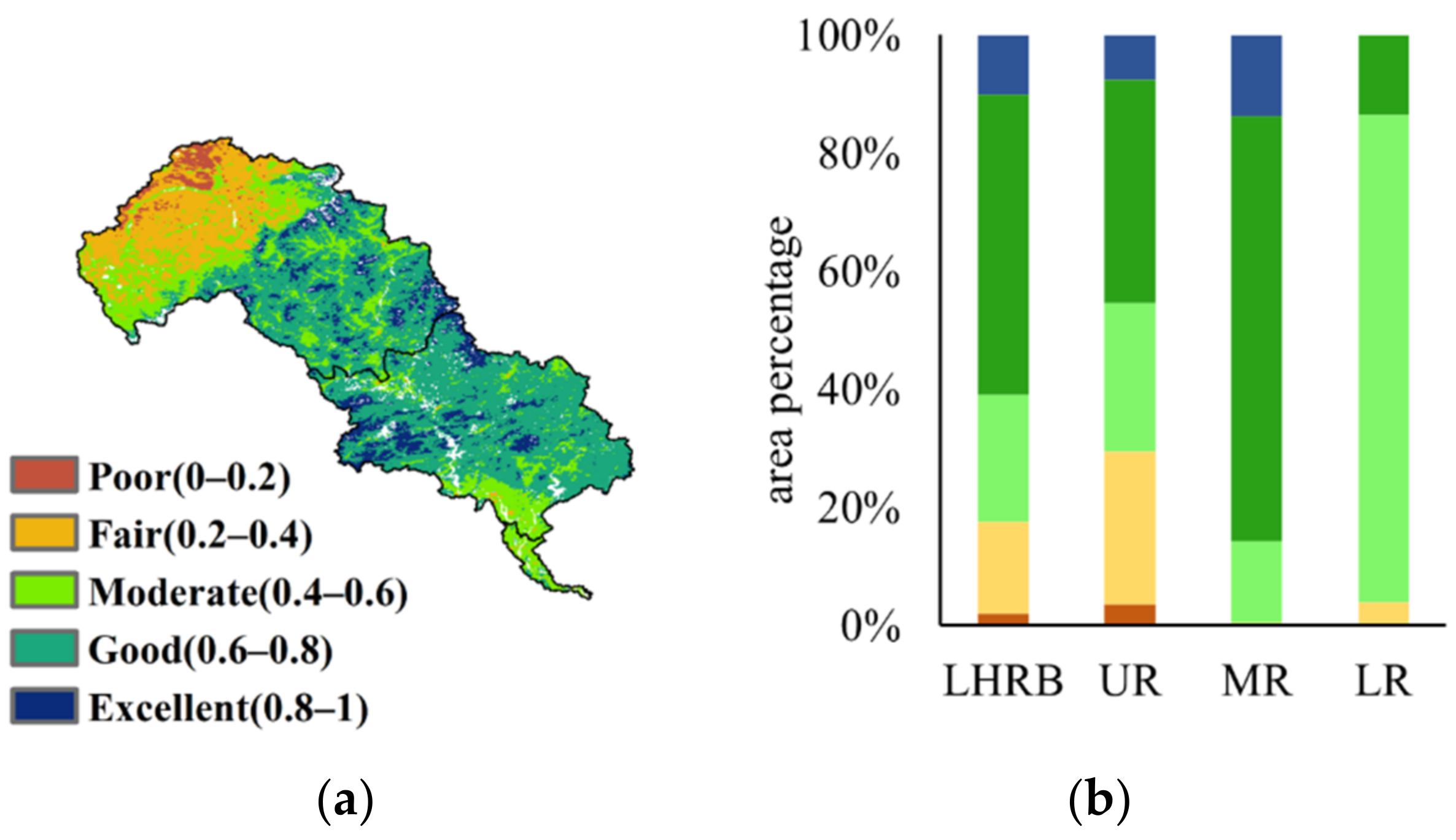
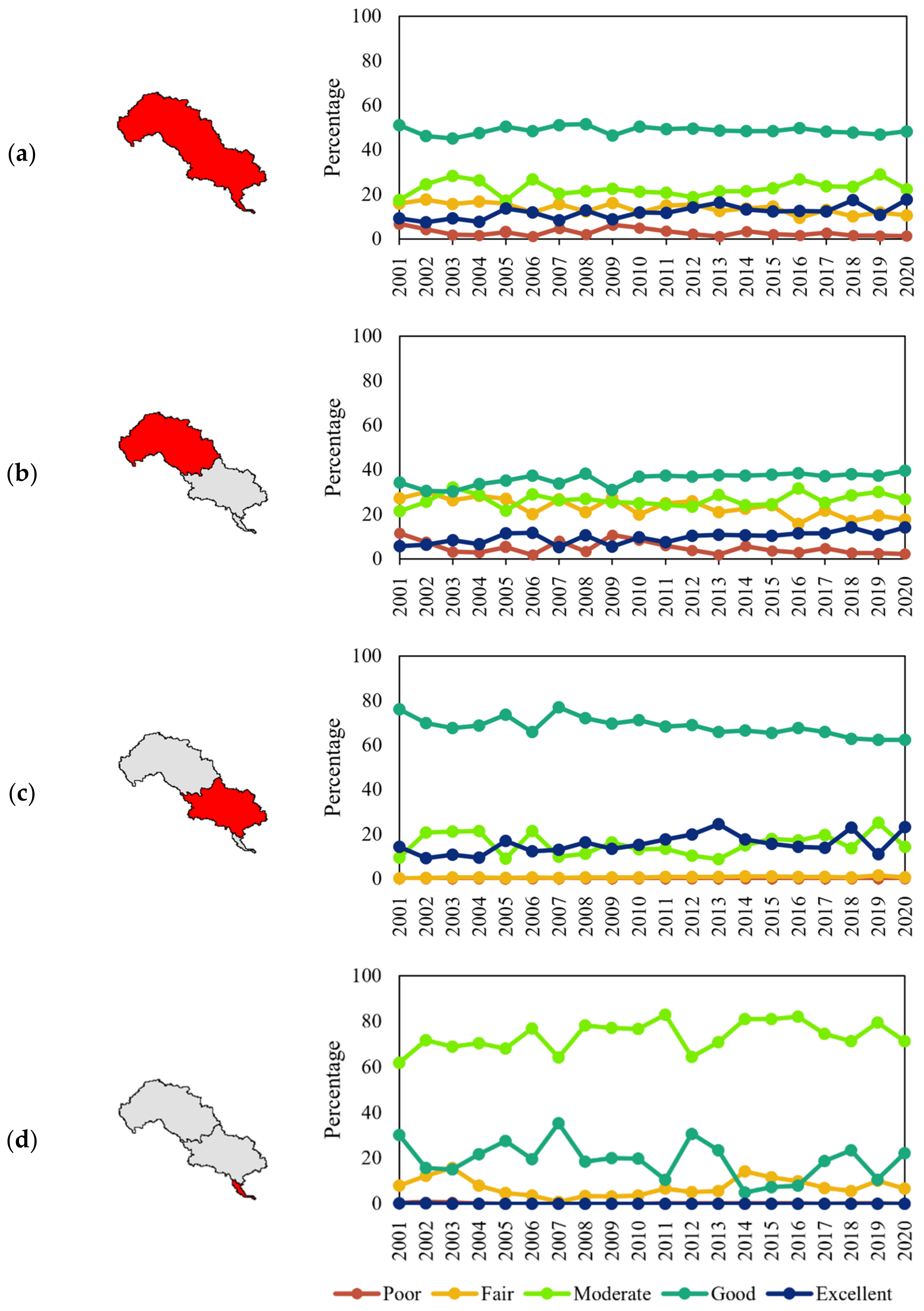
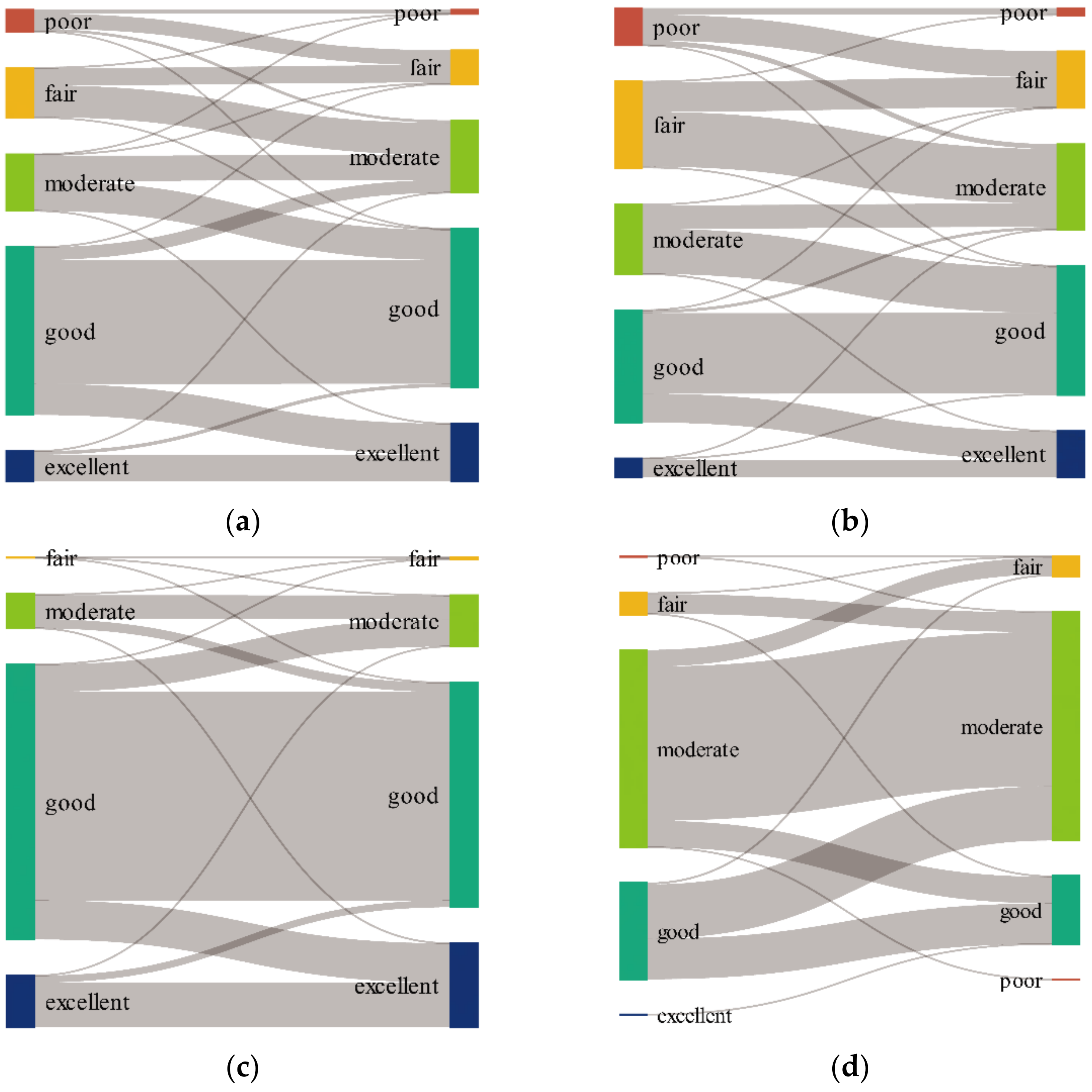
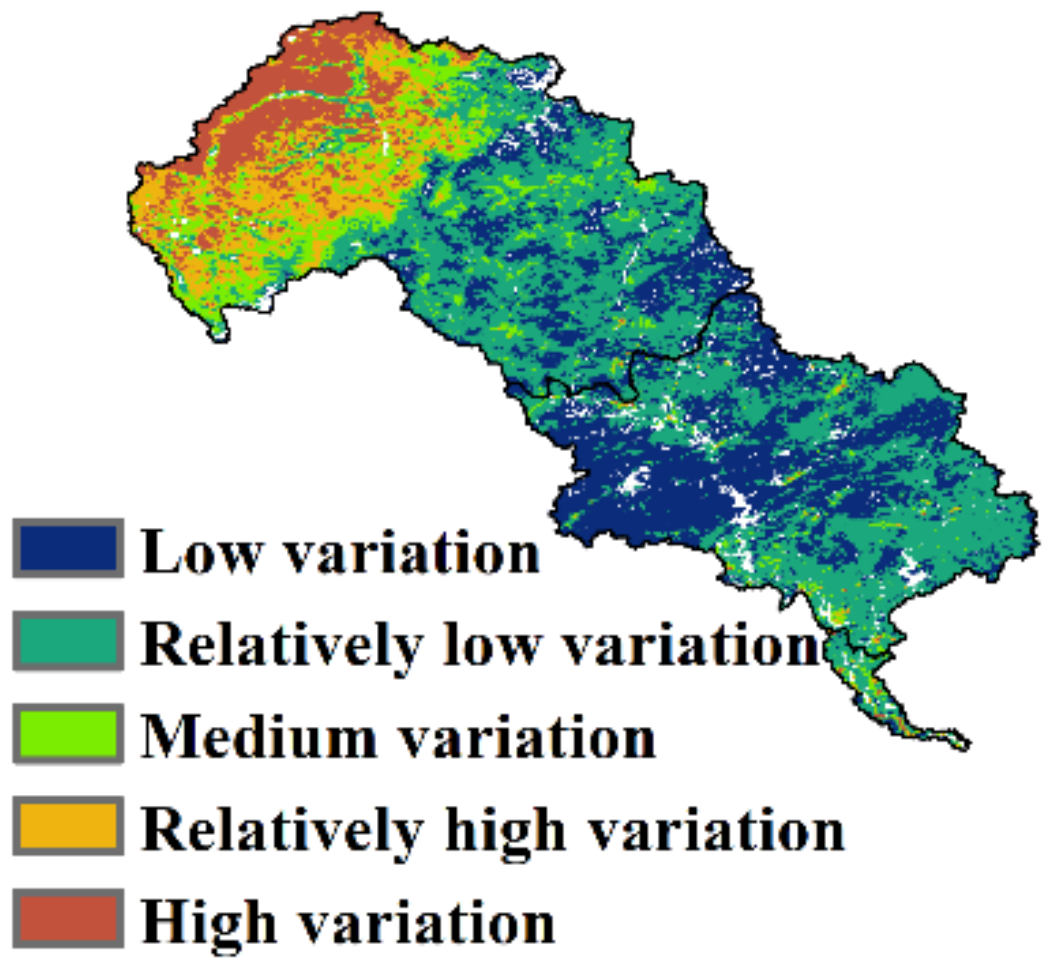

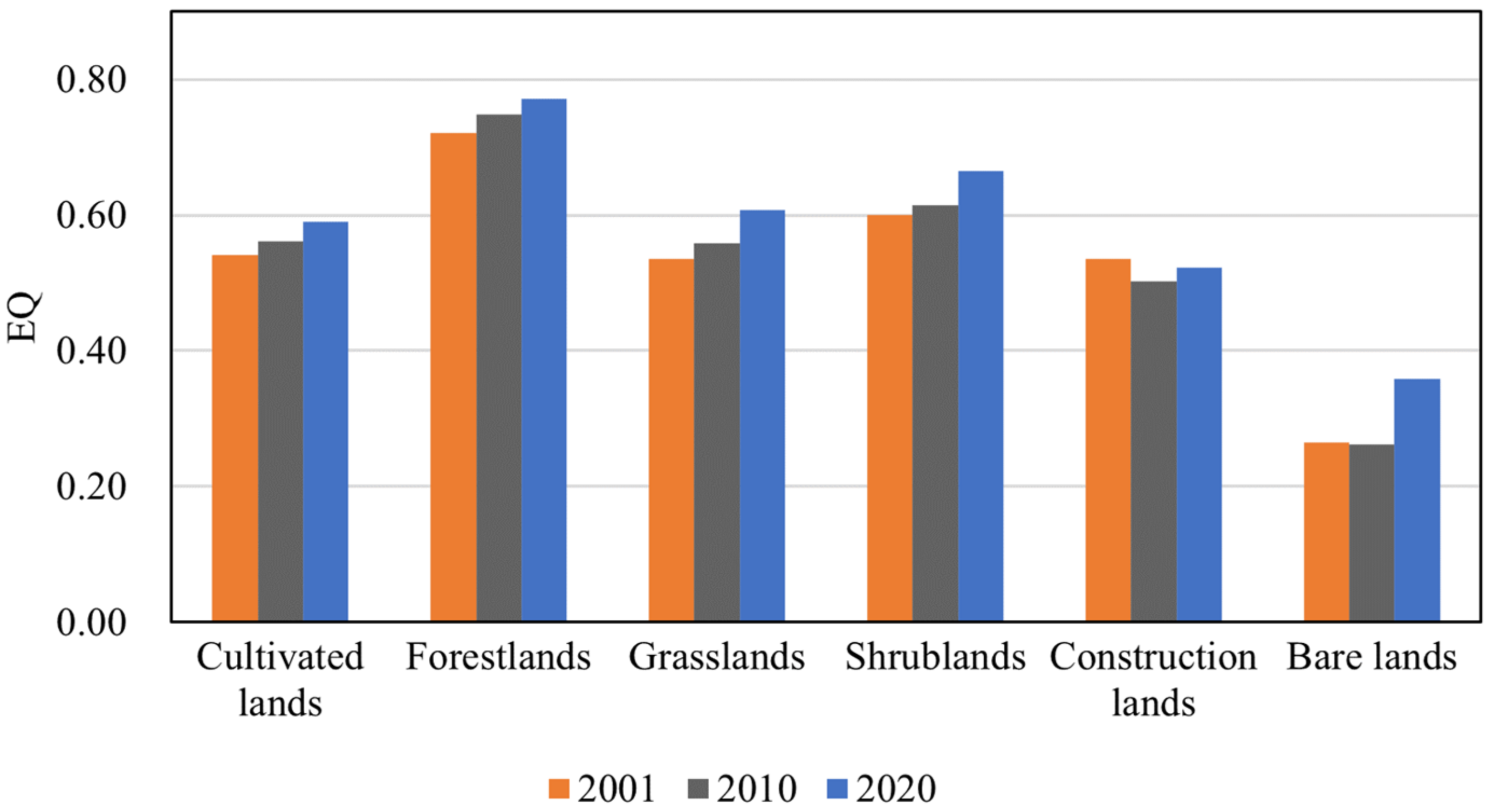

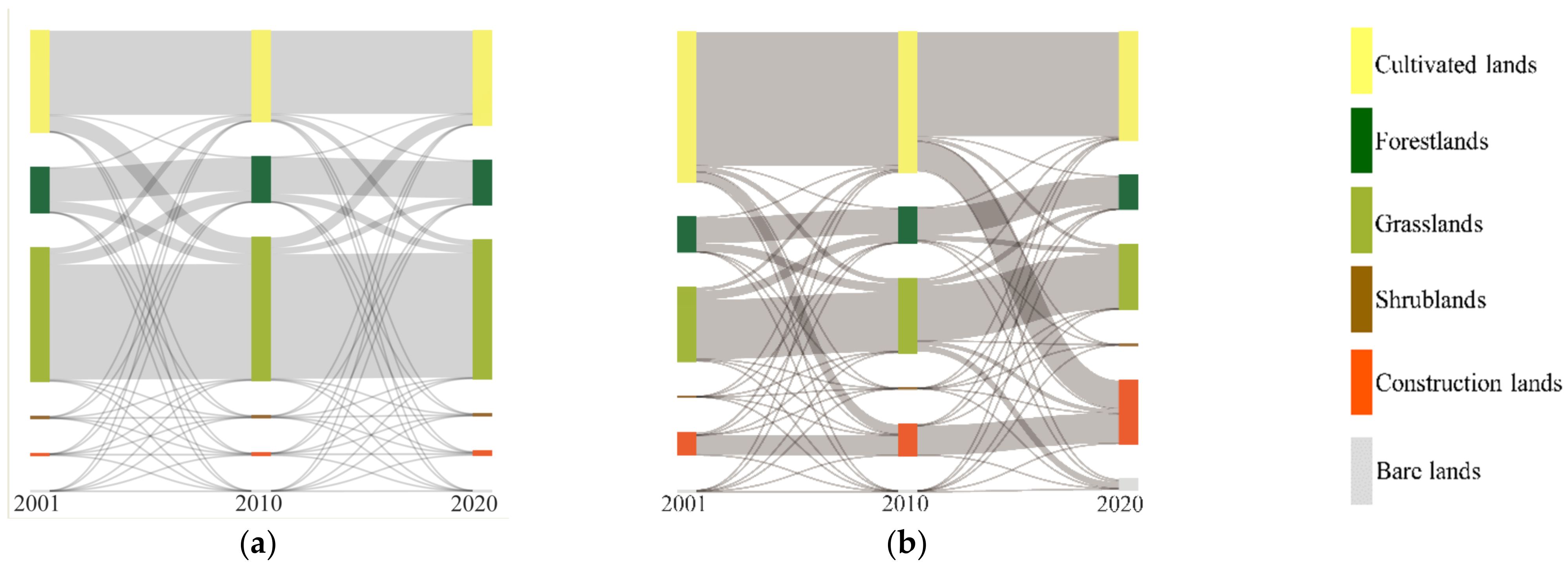
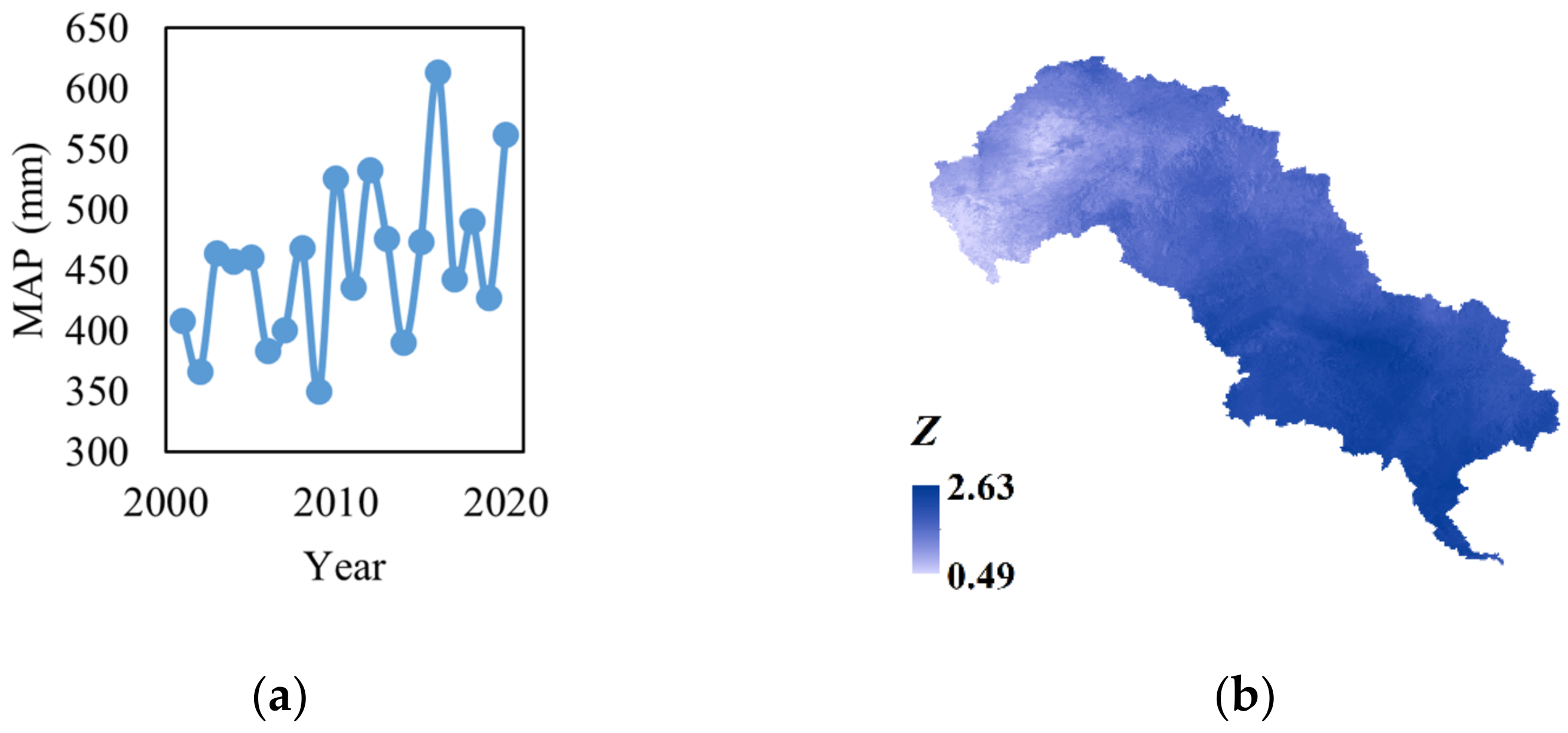

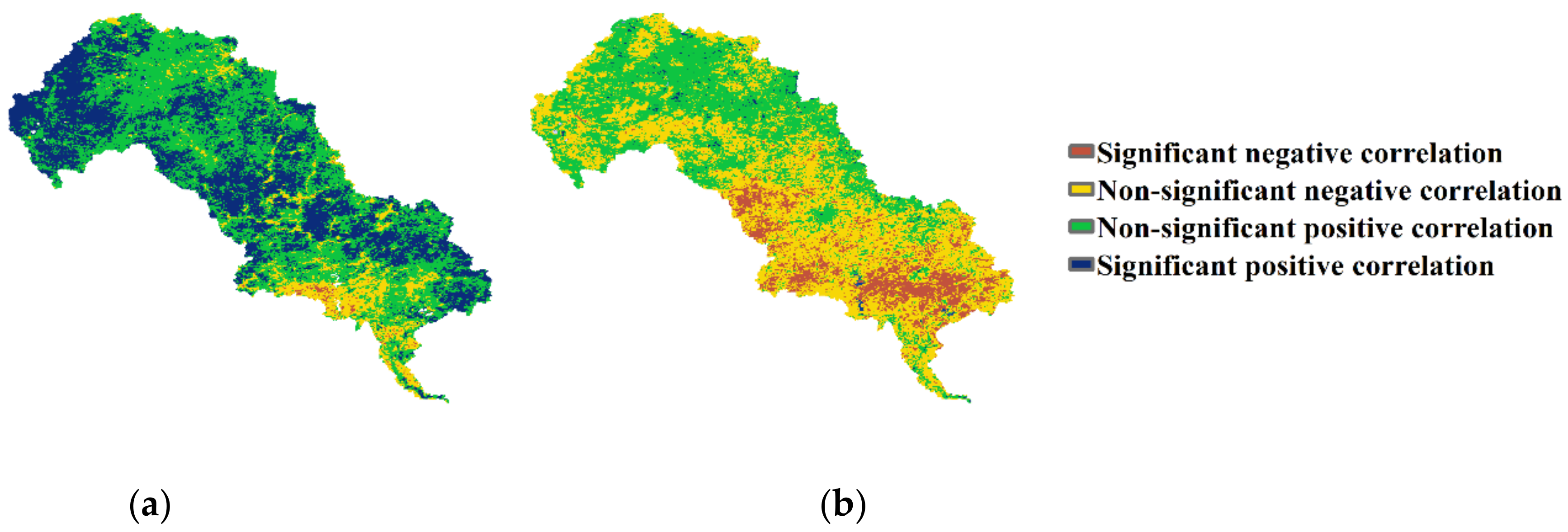
| CV | Variation Degree | Percentage | |||
|---|---|---|---|---|---|
| LHRB | UR | MR | LR | ||
| ≤0.05 | Low variation | 29.32% | 16.66% | 45.60% | 10.02% |
| 0.05–0.10 | Relatively low variation | 42.80% | 38.15% | 48.76% | 64.84% |
| 0.10–0.15 | Medium variation | 10.10% | 15.48% | 2.05% | 15.77% |
| 0.15–0.20 | Relatively high variation | 8.85% | 14.76% | 0.43% | 4.82% |
| >0.20 | High variation | 8.92% | 14.95% | 0.16% | 4.56% |
| Test | Regions | |||
|---|---|---|---|---|
| LHRB | UR | MR | LR | |
| Z | 2.89 | 3.70 | 0.72 | −1.24 |
| β (Theil-Sen) | Z (Mann-Kendall) | Trend | Percentage | |||
|---|---|---|---|---|---|---|
| LHRB | UR | MR | LR | |||
| β < 0 | Z < −1.96 | Serious degradation | 7.35% | 1.98% | 13.77% | 38.82% |
| β < 0 | −1.96 < Z < 1.96 | Light degradation | 15.74% | 11.31% | 21.49% | 30.50% |
| β > 0 | −1.96 < Z < 1.96 | Light improvement | 34.39% | 34.05% | 35.53% | 19.40% |
| β > 0 | Z > 1.96 | Strong improvement | 42.52% | 52.67% | 29.21% | 11.28% |
| Year | Contribution (%) | Loading on PC1 | ||||
|---|---|---|---|---|---|---|
| PC1 | PC2 | NDVI | LST | WET | NDBSI | |
| 2001 | 91.86 | 4.90 | 0.50 | −0.61 | 0.52 | −0.44 |
| 2002 | 89.98 | 6.49 | 0.46 | −0.50 | 0.66 | −0.43 |
| 2003 | 82.35 | 13.77 | 0.39 | −0.42 | 0.60 | −0.35 |
| 2004 | 85.74 | 10.49 | 0.46 | −0.63 | 0.67 | −0.41 |
| 2005 | 89.79 | 7.02 | 0.41 | −0.53 | 0.56 | −0.42 |
| 2006 | 82.36 | 13.45 | 0.39 | −0.49 | 0.59 | −0.36 |
| 2007 | 92.51 | 4.23 | 0.50 | −0.61 | 0.59 | −0.46 |
| 2008 | 88.15 | 8.23 | 0.42 | −0.64 | 0.63 | −0.44 |
| 2009 | 90.80 | 5.99 | 0.51 | −0.53 | 0.60 | −0.45 |
| 2010 | 92.85 | 3.92 | 0.43 | −0.64 | 0.59 | −0.45 |
| 2011 | 91.36 | 5.26 | 0.44 | −0.59 | 0.62 | −0.44 |
| 2012 | 90.31 | 5.99 | 0.42 | −0.61 | 0.67 | −0.46 |
| 2013 | 83.24 | 12.90 | 0.34 | −0.35 | 0.48 | −0.33 |
| 2014 | 87.67 | 8.94 | 0.42 | −0.52 | 0.53 | −0.40 |
| 2015 | 84.04 | 12.01 | 0.32 | −0.45 | 0.52 | −0.33 |
| 2016 | 86.75 | 9.20 | 0.40 | −0.53 | 0.54 | −0.36 |
| 2017 | 88.02 | 8.07 | 0.41 | −0.54 | 0.57 | −0.39 |
| 2018 | 86.81 | 8.88 | 0.39 | −0.53 | 0.59 | −0.38 |
| 2019 | 85.77 | 10.12 | 0.38 | −0.55 | 0.62 | −0.37 |
| 2020 | 82.71 | 13.52 | 0.32 | −0.36 | 0.48 | −0.33 |
Publisher’s Note: MDPI stays neutral with regard to jurisdictional claims in published maps and institutional affiliations. |
© 2022 by the authors. Licensee MDPI, Basel, Switzerland. This article is an open access article distributed under the terms and conditions of the Creative Commons Attribution (CC BY) license (https://creativecommons.org/licenses/by/4.0/).
Share and Cite
Zhang, Y.; Song, T.; Fan, J.; Man, W.; Liu, M.; Zhao, Y.; Zheng, H.; Liu, Y.; Li, C.; Song, J.; et al. Land Use and Climate Change Altered the Ecological Quality in the Luanhe River Basin. Int. J. Environ. Res. Public Health 2022, 19, 7719. https://doi.org/10.3390/ijerph19137719
Zhang Y, Song T, Fan J, Man W, Liu M, Zhao Y, Zheng H, Liu Y, Li C, Song J, et al. Land Use and Climate Change Altered the Ecological Quality in the Luanhe River Basin. International Journal of Environmental Research and Public Health. 2022; 19(13):7719. https://doi.org/10.3390/ijerph19137719
Chicago/Turabian StyleZhang, Yongbin, Tanglei Song, Jihao Fan, Weidong Man, Mingyue Liu, Yongqiang Zhao, Hao Zheng, Yahui Liu, Chunyu Li, Jingru Song, and et al. 2022. "Land Use and Climate Change Altered the Ecological Quality in the Luanhe River Basin" International Journal of Environmental Research and Public Health 19, no. 13: 7719. https://doi.org/10.3390/ijerph19137719
APA StyleZhang, Y., Song, T., Fan, J., Man, W., Liu, M., Zhao, Y., Zheng, H., Liu, Y., Li, C., Song, J., Yang, X., & Du, J. (2022). Land Use and Climate Change Altered the Ecological Quality in the Luanhe River Basin. International Journal of Environmental Research and Public Health, 19(13), 7719. https://doi.org/10.3390/ijerph19137719







